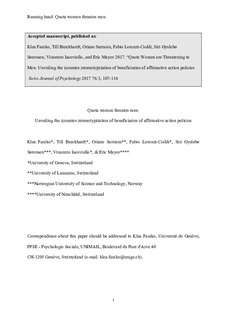Quota women are threatening to men: Unveiling the (counter)stereotypization of beneficiaries of affirmative action policies
Faniko, Klea; Burckhardt, Till; Sarrasin, Oriane; Lorenzi-Cioldi, F.; Sørensen, Siri Øyslebø; Iacoviello, Vincenzo; Mayor, Eric
Journal article, Peer reviewed
Accepted version
Permanent lenke
http://hdl.handle.net/11250/2481078Utgivelsesdato
2017Metadata
Vis full innførselSamlinger
Sammendrag
Abstract. Two studies carried out among Albanian public-sector employees examined the impact of different types of affirmative action policies (AAPs) on (counter)stereotypical perceptions of women in decision-making positions. Study 1 (N = 178) revealed that participants – especially women – perceived women in decision-making positions as more masculine (i.e., agentic) than feminine (i.e., communal). Study 2 (N = 239) showed that different types of AA had different effects on the attribution of gender stereotypes to AAP beneficiaries: Women benefiting from a quota policy were perceived as being more communal than agentic, while those benefiting from weak preferential treatment were perceived as being more agentic than communal. Furthermore, we examined how the belief that AAPs threaten men’s access to decision-making positions influenced the attribution of these traits to AAP beneficiaries. The results showed that men who reported high levels of perceived threat, as compared to men who reported low levels of perceived threat, attributed more communal than agentic traits to the beneficiaries of quotas. These findings suggest that AAPs may have created a backlash against its beneficiaries by emphasizing gender-stereotypical or counterstereotypical traits. Thus, the framing of AAPs, for instance, as a matter of enhancing organizational performance, in the process of policy making and implementation, may be a crucial tool to countering potential backlash.
